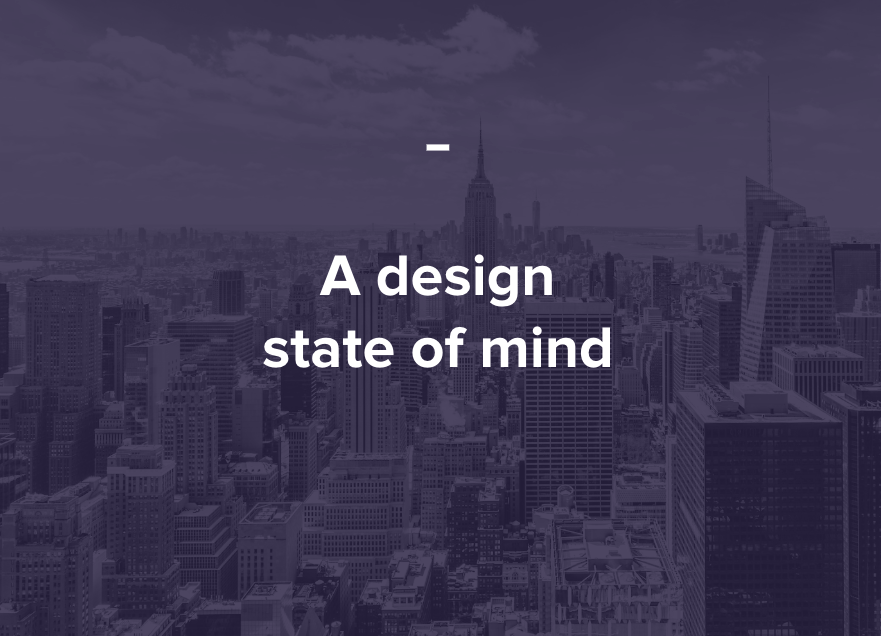A design state of mind
What it means to move to a design mindset.

A mindset is how we respond to the world around us. It acts as a centre of gravity. It goes with you. It shapes who you are and what you do, wherever you are.
Billy Joel wrote the song New York State of Mind after returning to New York City from LA. The lyrics and emotion of the song paint a picture of how much he loves the city. New York has always been a part of who he is, even when living in Los Angeles. He’s always been tuned-in to the fast pace, the hustle of the streets and idea that anything is possible. A New York state of mind.
Moving to a design mindset
We often talk at FutureGov (now TPXimpact) about the importance of moving teams and individuals to a design mindset. Taking this approach is how we can focus on delivering the highest quality services that have a lasting impact for all.
Most importantly a design mindset helps us focus on people. It’s how we reframe problems, enabling us to imagine future scenarios that will require new types of service and business models to deliver improved outcomes.
If our mindset is how we respond to our immediate surroundings and work, a design mindset means asking different types of questions and requires a different set of responses to the challenges we face.
This is how I would describe moving to a design mindset. And, as importantly, where this means we are moving from…
1. From Business/Technical …To User-focused
Moving from “It works like this to maintain BAU or meet requirements” …Moving to: “It could work like this for people in the future.”
2. From Complexity …To Simplicity
Moving from “We’re dealing with great complexity” …Moving to: “Let’s go back to first principles.”
3. From “We can’t change that” …To “We can change that”
Moving from: “Absolutely not…” …Moving to: “Why not…”
4. From Needing Certainty …To Not Knowing
Moving from: “We need certainty.” …Moving to: “Ambiguity is okay, we can learn more by doing.”
5. From Fixed Assumptions …To Changing Our Minds
Moving from “How can we prove we’re right?” …Moving to: “How might we be wrong about this?”
6. From Closed …To Open
Moving from: “There’s no need to share/make work visible.” …Moving to: “Collaboration connects and creates new ideas.”
The ‘moving from’ attributes described here aren’t necessarily wrong or unimportant. However, they show a different type of focus, more towards dealing in certainty and maintaining existing ways of operating. In contrast, a view of the world shaped by the questions a designer asks, and how they respond, is much more about future thinking. This means being open-minded to new ideas and types of collaboration.
Changing habits
Our experiences and the place we find ourselves shapes our state of mind. The longer you spend somewhere or with something, the more it becomes a part of you. So, we need to shape our ways of working, and the places we work, as they will continue to shape us.
Holding and developing an alternate state of mind is a challenge. It’s hard work. But it’s an important challenge if we want to help shape future organisations. I’ve seen firsthand that it’s possible to shape new behaviours and norms in the way teams and individuals question and respond to challenges.
To get started, be prepared to look at your own mindset as much as that of everyone else working around you. Stop or pause to challenge yourself. Think about how you react to the different situations and scenarios you’re in. Reflect on how you respond. Evaluate the differences that small changes to default behaviours and adopting new perspectives can start to make.
Just like New York, if you live with something for long enough it becomes part of you. A design mindset is something that everyone can move to. You have to be deliberate about going there. And if you’re deliberate about staying there long enough you will find it starts to go everywhere with you as well.
This post was originally published on the FutureGov blog – Feb 4 2019. It was updated/refreshed for this blog in 2025.
This is my blog where I’ve been writing for 20 years. You can follow all of my posts by subscribing to this RSS feed. You can also find me on Bluesky and LinkedIn.